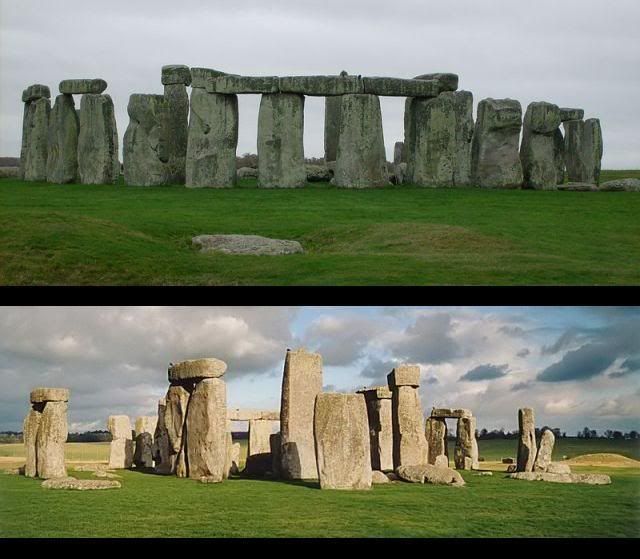Post by bluefedish on Dec 11, 2007 14:48:36 GMT -5
A prehistoric monument located in the English county of Wiltshire, about 8 miles north of Salisbury. One of the most famous prehistoric sites in the world, Stonehenge is composed of earthworks surrounding a circular setting of large standing stones. Archaeologists believe that the standing stones were erected around 2200 BC and the surrounding circular earth bank and ditch, which constitute the earliest phase of the monument, have been dated to about 3100 BC. The site and its surroundings were added to the UNESCO's list of World Heritage Sites in 1986 in a co-listing with Avebury henge monument, and it is also a legally protected Scheduled Ancient Monument. Stonehenge itself is owned by the State and managed by English Heritage while the surrounding land is owned by the National Trust.
History
The Stonehenge complex was built in several construction phases spanning at least 3000 years, although there is evidence for activity both before and afterwards on the site, perhaps extending its time frame to 6500 years.
Dating and understanding the various phases of activity at Stonehenge is not a simple task; it is complicated by poorly kept early excavation records, surprisingly few accurate scientific dates and the disturbance of the natural chalk by periglacial effects and animal burrowing. The modern phasing most generally agreed by archaeologists is detailed below. Features mentioned in the text are numbered and shown on the plan, right, which illustrates the site as of 2004. The plan omits the trilithon lintels for clarity. Holes that no longer, or never, contained stones are shown as open circles and stones visible today are shown coloured.
Recent History
By the beginning of the 20th century a number of the stones had fallen or were leaning precariously, probably due to the increase in curious visitors clambering on them during the nineteenth century. Three phases of conservation work were undertaken which righted some unstable or fallen stones and carefully replaced them in their original positions using information from antiquarian drawings.
Stonehenge is a place of pilgrimage for neo-druids and those following pagan or neo-pagan beliefs. The midsummer sunrise began attracting modern visitors in the 1870s, with the first record of recreated Druidic practices dating to 1905 when the Ancient Order of Druids enacted a ceremony. Despite efforts by archaeologists and historians to stress the differences between the Iron Age Druidic religion and the much older monument, Stonehenge has become increasingly, almost inextricably, associated with British Druidism, Neo Paganism and New Age philosophy. After the Battle of the Beanfield in 1985 this use of the site was stopped for several years, and currently ritual use of Stonehenge is carefully controlled.
In more recent years, the setting of the monument has been affected by the proximity of the A303 road between Amesbury and Winterbourne Stoke, and the A344. Early in 2003, the Department for Transport announced that the A303 would be upgraded, including the construction of the Stonehenge road tunnel. On 06 December 2007 it was announced that the plans had been cancelled.

Selected Source:
en.wikipedia.org/wiki/Stonehenge
History
The Stonehenge complex was built in several construction phases spanning at least 3000 years, although there is evidence for activity both before and afterwards on the site, perhaps extending its time frame to 6500 years.
Dating and understanding the various phases of activity at Stonehenge is not a simple task; it is complicated by poorly kept early excavation records, surprisingly few accurate scientific dates and the disturbance of the natural chalk by periglacial effects and animal burrowing. The modern phasing most generally agreed by archaeologists is detailed below. Features mentioned in the text are numbered and shown on the plan, right, which illustrates the site as of 2004. The plan omits the trilithon lintels for clarity. Holes that no longer, or never, contained stones are shown as open circles and stones visible today are shown coloured.
Recent History
By the beginning of the 20th century a number of the stones had fallen or were leaning precariously, probably due to the increase in curious visitors clambering on them during the nineteenth century. Three phases of conservation work were undertaken which righted some unstable or fallen stones and carefully replaced them in their original positions using information from antiquarian drawings.
Stonehenge is a place of pilgrimage for neo-druids and those following pagan or neo-pagan beliefs. The midsummer sunrise began attracting modern visitors in the 1870s, with the first record of recreated Druidic practices dating to 1905 when the Ancient Order of Druids enacted a ceremony. Despite efforts by archaeologists and historians to stress the differences between the Iron Age Druidic religion and the much older monument, Stonehenge has become increasingly, almost inextricably, associated with British Druidism, Neo Paganism and New Age philosophy. After the Battle of the Beanfield in 1985 this use of the site was stopped for several years, and currently ritual use of Stonehenge is carefully controlled.
In more recent years, the setting of the monument has been affected by the proximity of the A303 road between Amesbury and Winterbourne Stoke, and the A344. Early in 2003, the Department for Transport announced that the A303 would be upgraded, including the construction of the Stonehenge road tunnel. On 06 December 2007 it was announced that the plans had been cancelled.

Selected Source:
en.wikipedia.org/wiki/Stonehenge



